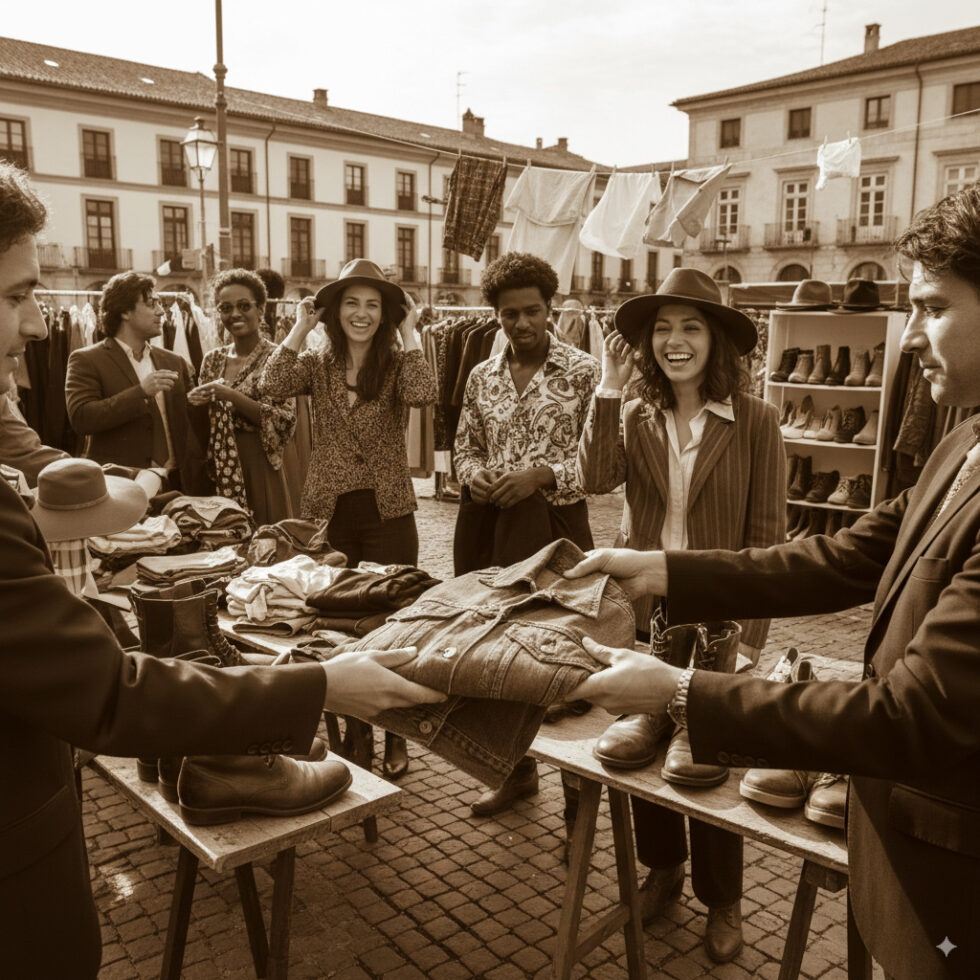
For years, “buy once, use once” defined modern consumer life. Today, a different rhythm is spreading across countries and screens. People are buying secondhand, repairing, renting, and reselling—often across borders—turning closets, garages, and storage rooms into small economies. This is recommerce: a fast-growing web of marketplaces, repair networks, and local lending services that redefine ownership.
It is not just about bargains or sustainability. Recommerce changes daily routines. You plan a trip and rent a stroller at your destination. You pick a winter coat, knowing it will be easy to resell. You borrow a tile saw from a neighborhood library of things instead of buying one. And when you do buy, you check not only the price, but the likely resale value and the ease of cross-border shipping. The result is a lifestyle that feels lighter, more flexible, and more connected to a global flow of goods.
What Recommerce Looks Like Right Now
Recommerce spans many categories but follows a simple idea: goods move from one owner to another with strong support for discovery, trust, and logistics. It includes peer-to-peer clothing swaps, certified refurbished electronics, designer consignment with authentication, outdoor gear rentals, and tool libraries run by cities or clubs. Some activity is local; much of it is cross-border, helped by platforms that coordinate shipping, customs, and translation.
Fashion: From Closet to Worldwide Audience
Secondhand fashion sits at the heart of recommerce. Individuals list items with detailed photos, measurements, and condition notes. Buyers filter by size, style, era, and fabric. Stylists and micro‑sellers build reputations, often specializing in niches like Japanese denim, archival sportswear, or vintage dresses. Cross-border demand helps sellers find the right buyer at the right price, while buyers discover styles that rarely show up in local stores.
Fashion recommerce isn’t only about “thrifting.” It includes premium consignments with authentication checks, as well as mid-tier basics that move quickly. Many sellers treat their wardrobes like rotating collections: they keep a piece for a season or two, then pass it on, capturing part of the original purchase price. The ease of listing and shipping turns fashion into a more fluid part of lifestyle planning.
Electronics and Home Gear: Refurbish, Then Resell Again
Recommerce for electronics leans on certified refurbishers and clear grading. Laptops and phones are inspected, worn parts replaced, and battery health documented. Buyers get transparent ratings, warranty options, and, crucially, an understanding of regional compatibility (cell bands, power plugs, and service policies).
Home goods follow a similar arc. Furniture moves through buy‑back programs or consignment platforms. Kitchen appliances with long lives and spare parts—mixers, espresso machines, vacuum cleaners—are prime candidates for repair and resale. The setup is pragmatic: invest in durable brands with known parts availability, then resell when your space or needs change.
Rentals and Libraries: Use, Don’t Own
Rental services for clothing and gear fill the gaps. Travelers rent ski equipment abroad rather than paying for oversized baggage. Photographers try lenses for a weekend assignment. Families borrow a car seat at their destination. In many cities, tool libraries provide occasional access to sanders, tile cutters, and specialty tools. The appeal is simple: you get high-quality equipment when you need it, without storage headaches or full purchase costs.
How Global Logistics Makes It Work
Behind the scenes, a global web of shipping partners, pickup points, and customs brokers keeps recommerce moving. You rarely see the details, but several trends matter for everyday users:
Simplified Cross-Border Parcels
Platforms increasingly offer labels that include customs declarations, harmonized codes, and duty prepayment. Transactions often use Delivered Duty Paid (DDP), so buyers don’t face surprise fees upon delivery. Local pickup points—lockers and counters in convenience stores—reduce failed deliveries and help keep shipping costs manageable.
Trust That Travels
Reputation systems matter. Ratings, return policies, and item grading standards create confidence between strangers. Some platforms add optional authentication for high‑value goods. Consistent grading terms—such as “like new,” “excellent,” “good,” and “fair”—build shared expectations. When these standards are enforced globally, cross-border deals feel safer and smoother.
Data That Speeds Up Decisions
Listings are richer than ever: precise measurements for clothing, detailed photos of wear, battery health screenshots for phones, or receipts showing original purchase. These reduce back‑and‑forth questions and enable faster shipping. Translation tools help buyers understand listings in other languages. The more complete the listing, the more likely a smooth transaction and a happy resale down the line.
Lifestyle Shifts You Can Feel
Recommerce is not only a shopping category; it’s a habit that reorders daily choices.
Budgets Become Elastic
Resale value enters the mental math. If you know a winter jacket or a desk lamp has a good second life, you’re more comfortable buying quality upfront. Families often rotate baby gear through multiple homes, spreading costs and reducing waste. Students moving between countries cushion relocation expenses by buying used locally and reselling before leaving.
Homes Run on Shared Tools
Purchasing is no longer binary. You might own a core set of tools but borrow specialized items. Tool libraries and neighbors fill in the rest. This lowers clutter and pushes people to think in terms of access rather than ownership. It also builds a soft community fabric: conversations at pickup counters, quick tips shared with the next user, reviews that mention “here’s how I used it.”
Style Is a Global Conversation
Recommerce platforms act like cultural routers. Scandinavian chairs end up in Mexico City apartments; Brazilian swimwear finds fans in Tokyo; Japanese workwear lands in Berlin. The result is a slow blend of aesthetic ideas. You can shop locally while staying deeply connected to wider trends, anchored by fit, material, and craft rather than just brand logos.
Repair becomes routine
Repair is no longer a last resort; it is part of the product lifecycle. Users learn simple fixes—replacing vacuum belts, polishing leather, swapping phone batteries—thanks to guides and videos. Local repair shops and community fix‑it events reduce the friction. The social status shifts too: a neat repair is seen as a mark of care, not a flaw.
Practical Things to Know Before You Dive In
You don’t need to become an expert to benefit from recommerce, but a few details save time and money.
Clothing and Footwear
- Check measurements, not just size labels. Size systems vary. Compare listed measurements to items you own.
- Look for material details. Natural fibers age differently than synthetics; blends affect drape and durability.
- Mind seasonality. Selling winter gear in spring may be slower—unless you list cross‑border into colder regions.
Electronics and Appliances
- Confirm regional compatibility. Phones need matching bands; consoles and streaming devices may have region locks; appliances may require voltage converters.
- Ask for battery health and service history. Photos of diagnostics help. Favor listings with remaining warranty or clear refurb checks.
- Pack safely if you sell. Use original packaging or double‑box fragile items and protect corners.
Shipping and Customs
- Use platform labels when possible. They often include customs forms and benefit from negotiated rates.
- Know duty thresholds and DDP options. Prepaid duties reduce delivery delays and surprise costs.
- Choose pickup points for reliability. Lockers and staffed counters lower theft and re‑delivery attempts.
Rental and Libraries
- Inspect on pickup. Note wear and take quick photos. It protects you and speeds returns for the next user.
- Practice basic care: dry gear before return, coil cables, and report issues promptly.
- Book ahead for peak seasons—ski weeks, festival dates, moving weekends.
The Environmental Reality Check
Many people embrace recommerce to reduce waste. That intuition is sound, but the details matter. Shipping still produces emissions; the benefits depend on what is being replaced and how often items are used.
When It Helps Most
Recommerce works well for products with long lifespans and repairable parts: quality clothing, durable furniture, cameras, and pro‑level tools. Every additional owner stretches the product’s useful life, delaying a new purchase and the manufacturing impact that comes with it. Buying used within your region cuts transport distances further.
What to Watch
Fast returns and frequent exchanges can erode gains, especially for items that travel far multiple times. Packaging waste adds up if boxes and padding are single-use. That said, consolidated shipping, pickup points, and better matching (thanks to richer listings and measurements) reduce these pains.
Counterfeits harm both buyers and the environment by creating throwaway goods. Choose platforms with strong authenticity checks for high‑value items. Look for clear, high‑resolution photos, brand tags, and serial numbers. When in doubt, ask for extra documentation.
What’s Coming Next
Recommerce is still evolving. Several developments will make it smoother and more mainstream.
Product Passports
Expect more items to carry a scannable history: materials, repairs, ownership transfers, and recycling guidance. These digital product passports help buyers assess quality and help sellers prove care. They can also direct products to approved repair shops and recyclers at end of life.
Standard Condition Grades
Fashion, electronics, and furniture platforms are converging on consistent grading terms. That consistency makes cross-border deals easier. Once you learn a standard on one site, you can apply it elsewhere with fewer surprises.
Repair as a Service
Brands and third parties are building networks where you can book fixes inside the platform flow. A “repair” button next to “buy” and “sell” normalizes maintenance. These services bring spare parts and expertise closer to where goods already are.
Local Hubs, Global Reach
Neighborhood lockers and counters will become the default handoff points. On the back end, regional sorting centers consolidate packages and move them across borders efficiently. The result is a system that feels local to you, even when your gloves came from Oslo and your lamp heads to Valencia next.
Smarter Listings and Discovery
Better translation, more precise tagging, and intelligent image search will cut friction. Shoppers will find “wool coat with raglan sleeves, charcoal, size 40” in minutes, not hours. Sellers will see suggested prices and estimated time-to-sell based on recent cross-border activity. These small boosts add up to a smoother routine.
Everyday Scenarios You Might Recognize
The Student Move
Amira moves from Cairo to Lisbon for a year. She arrives with a carry-on and buys used: a folding desk, a chair, and a lamp from local sellers. She keeps the boxes. Before returning home, she resells each item to new students landing the same week she leaves. Her net cost for a furnished year? Less than a month’s rent.
The Family Gear Shuffle
A family of four loves hiking but doesn’t want a garage full of equipment. They rent trekking poles when they travel, borrow a child carrier from a friends’ group, and buy used rain shells. When the kids grow, they resell items to families two countries away. Reviews and clear condition notes keep transactions quick and friendly.
The Creative Hobbyist
Jonas experiments with studio lighting. He buys a used light kit, tests it, resells part of it, and upgrades one head to a refurbished model. Over a year, he cycles through tools without locking in thousands of dollars. He documents care and packs items carefully, building a strong seller rating that becomes its own asset.
How to Build Your Personal Recommerce Routine
It starts small. Pick one category and set up a simple flow.
- Choose durable basics. Buy items with known spare parts and strong materials. Look up repair guides first.
- List honestly. Take clear photos, include measurements, note every flaw. Trust grows from transparency.
- Save packaging. A few sturdy boxes and bubble sleeves make shipping easy and reduce waste.
- Use pickup points. They save time and reduce missed deliveries.
- Track your cost of use. Purchase price minus resale price equals your actual cost. It’s often lower than you expect.
Why This Matters
Recommerce aligns daily life with global realities. It acknowledges that goods are more than impulse buys; they are assets with multiple useful lives. It connects households across borders with a common language of materials, condition, and care. It softens the environmental load without asking people to give up comfort or style. And it restores a certain thrift wisdom—well-made things, well cared for, find a next home.
Most of all, it returns agency. You decide when to own, when to rent, and when to pass an item along. You learn which products age gracefully and which ones don’t. You build small habits—saving boxes, photographing items in daylight, selecting durable fabrics—that pay off over time. That’s a lifestyle shift you can feel every day, whether you’re sending a jacket to a buyer in another country or borrowing a tile saw from a locker down the street.
Summary:
- Recommerce turns buying, repairing, renting, and reselling into a normal cycle that often spans borders.
- Fashion, electronics, home goods, and tools are leading categories, supported by richer listings, ratings, and authentication.
- Global logistics—customs-ready labels, DDP, and pickup points—make cross-border parcels routine.
- Daily life changes: budgets flex with resale value, homes rely on shared tools, and style becomes a global conversation.
- Practical wins come from measurements, regional compatibility checks, smart packing, and using platform shipping.
- Environmental benefits grow when durable goods get multiple owners and repair becomes routine.
- Coming next: product passports, standard grading, repair services inside platforms, and denser local hubs.




